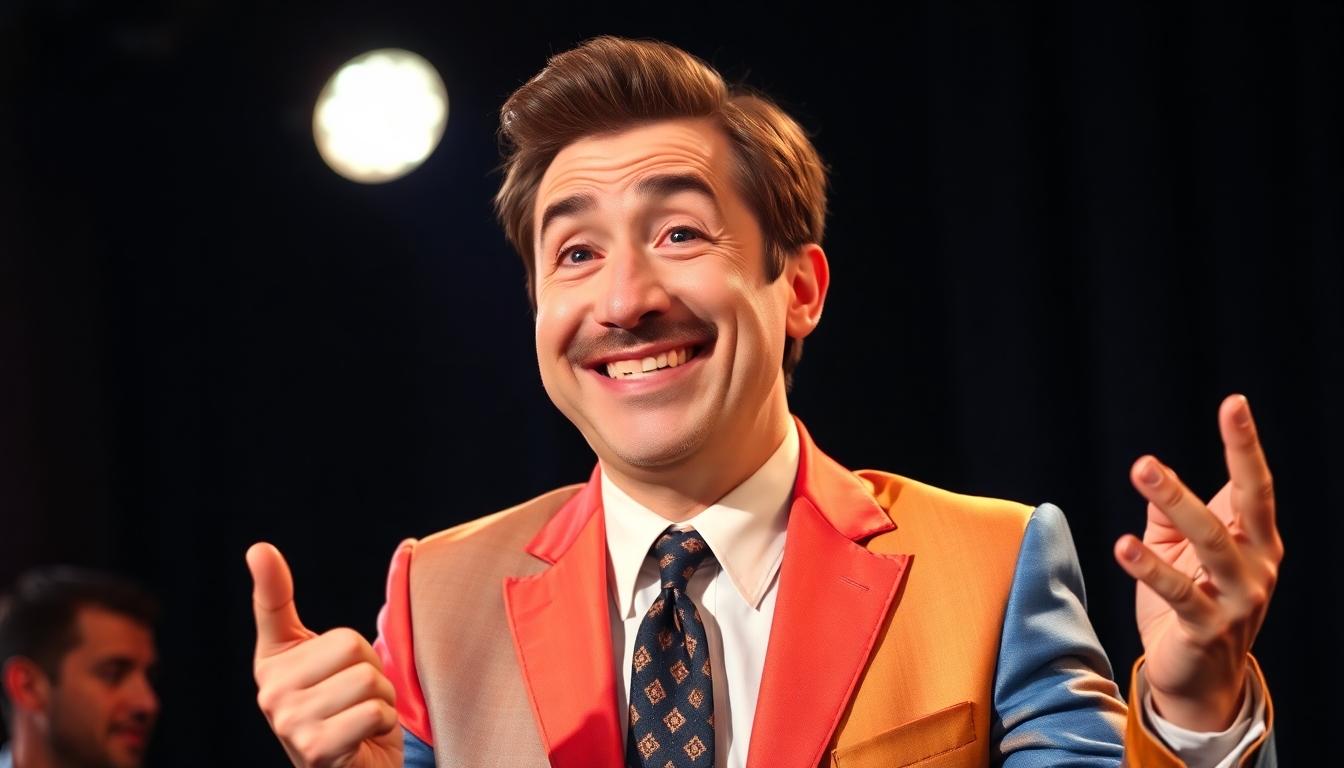Got a prominent proboscis? You’re not alone! We’ve all heard the jokes, and sometimes, the best way to handle them is to laugh along. That’s why we’ve gathered the funniest, most nose-worthy quips that celebrate those of us with more distinguished facial features.
10 Hilarious Jokes for Big Noses That Will Have You Breathing Easy
- The Weather Forecaster: People with big noses never need to watch the weather forecast. They can smell rain coming three days in advance!
- The Human Sundial: My nose is so large that people use it to tell time. When I face north, my shadow works better than any clock in town!
- The Oxygen Advantage: Why do people with big noses excel at marathons? They’ve got built-in oxygen tanks giving them a 20% breathing advantage over the competition!
- The Doorbell Dilemma: I’ve stopped ringing doorbells at friends’ houses. Every time I lean forward to press the button, my nose rings it first!
- The Swimming Secret: Swimming instructors always recruit people with prominent noses. We’re naturally buoyant – our noses work like personal flotation devices!
- The Perfume Tester: Perfume companies save thousands on testing equipment by hiring big-nosed people. We can detect scent notes that machines miss from across the room!
- The Sneeze Warning: Benefits of having a prominent nose include providing a 5-second warning before sneezing. Everyone in a 10-foot radius has time to take cover!
- The Wine Connoisseur: Sommeliers with larger noses have an unfair advantage in wine tasting competitions. They can smell the vintage, grape variety, and soil type before the bottle’s even opened!
- The COVID Test: During the pandemic, people with big noses had it rough. Regular COVID tests felt like they were swabbing our brains, while for us, they barely reached halfway!
Why Big Nose Jokes Are the Perfect Ice Breaker at Parties

Big nose jokes serve as effective humor tools at social gatherings by using exaggeration for comedic effect. When shared appropriately among friends or through self-deprecation, these jokes can create shared laughter and reduce tension in social settings.
Self-Deprecating Humor That Wins the Room
Self-referential jokes about prominent facial features can transform potential insecurity into instant relatability at parties. Research suggests that controlled self-deprecation might actually enhance likability, as dominant laughter patterns in teasing scenarios correlate with perceived social status. Try lines like “My nose doesn’t need Wi-Fi; it smells the signals” or “My nose is so big, elephants think it’s a rival trunk” to break the ice. These types of jokes shift attention from potential insecurity to creating a comfortable atmosphere where everyone feels welcome to laugh together.
Breaking Tension With Lighthearted Nose Jokes
Framing nose jokes as absurd comparisons helps avoid direct ridicule while still generating laughs. Statements such as “Your nose should teach geometry—it’s all about angles!” use hyperbole rather than meanness to create humor. Context matters tremendously when delivering these jokes, as they work best in trusted groups with mutual understanding. Effective party icebreakers using nose humor should always prioritize inclusivity and audience comfort levels. Jokes like “Your nose makes every mask a custom fit” or “Your nose is so advanced, it smells Wi-Fi signals” work well because they focus on imaginative scenarios rather than negative stereotypes.
Classic One-Liners About Prominent Proboscises

Nothing breaks the ice quite like a well-crafted nose joke that combines wit with a dash of anatomical exaggeration. These timeless one-liners have been making people chuckle for generations with their clever wordplay and vivid imagery.
Anatomical Humor That Never Fails
Anatomical humor remains a staple in the big nose joke repertoire. “Your nose is so big, elephants think it’s a rival trunk” perfectly captures the essence of comparing human features to animal counterparts for comedic effect. We find that functional wit also lands well with quips like “Your nose doesn’t get jet lag—it smells all time zones at once,” highlighting the imagined superpowers of an oversized sniffer.
Cultural references add another layer of humor, especially seasonal jokes such as “Your nose is so big, Santa uses it as a backup for Rudolph!” These references connect with audiences through shared cultural touchpoints. For those who appreciate classic literature, there’s always the vintage sarcasm of “Is that your nose, or did a bus park on your face?”—a joke format that traces back to Edmond Rostand’s famous character Cyrano de Bergerac.
Vintage Zingers That Stand the Test of Time
Meteorological humor continues to generate laughs with classics like “Everybody take cover, she’s going to blow!” This style of joke plays on the visual imagery of a nose as a geographic feature. Literary wordplay elevates nose jokes to an intellectual level with gems such as “Your nose should teach geometry—it’s all about angles!”
Childhood classics remain in circulation decades after their creation. “Your nose is so big that when you lie on your back in the pool… people think it’s a shark” demonstrates how these jokes transcend generations. Nostalgic puns create visual comedy, as with “When you blow out birthday candles, your nose takes the spotlight,” highlighting everyday situations transformed by prominent proboscises.
Celebrity-Inspired Big Nose Quips
Pop culture puns leverage famous names for maximum impact. “What do you call a man with a big nose who can predict the future? Nostrildamus!” cleverly combines nasal terminology with the name of famous prophet Nostradamus. Detective humor follows suit with nicknames like “Sherlock Nose” for those with prominent profiles and investigative skills.
Career-based jests translate workplace scenarios into nose humor with lines like “Your nose got its own office because it couldn’t fit in the cubicle.” Modern variations often incorporate technology themes, such as “Your nose doesn’t browse the web—it sniffs out the best pages,” demonstrating how these jokes evolve with contemporary culture while maintaining their fundamental structure.
Pun-tastic Nose Jokes That Will Make You Snort With Laughter

When it comes to nose humor, nothing beats a good pun that hits right on the nosetril. We’ve gathered some of the funniest nose-related wordplay that will have you breathing heavily with laughter.
Funny One-Liners
- Di-nose-saur — Prehistoric humor gets a nasal twist with this playful dinosaur pun.
- You nose it — This confident claim works perfectly when you’re absolutely certain about something.
- Your nose must be tired because it’s been running all day — A classic that plays on the dual meaning of a “running” nose.
- That joke really nose how to crack me up — When someone tells a joke so funny, this pun acknowledges their comedic talent.
- He always nose best — Perfect for describing that know-it-all friend who thinks they’re always right.
Wordplay That Centers Around Nasal Features
What makes nose jokes so special is their ability to highlight our distinctive nasal features in humorous ways. These puns celebrate prominent noses rather than mock them.
- What do you call someone who can catch a scent from miles away? A “sniff-sniffer” — This creative label perfectly describes those friends with superhuman smelling abilities.
- With a nose like that, who needs glasses? — A clever comparison that turns a prominent nose into a useful feature rather than something to be self-conscious about.
- She had a nose for trouble, always getting into mischief — This common expression takes on new humor when applied to someone who consistently finds themselves in sticky situations.
Clever Comebacks for Nose-Related Teasing
Armed with these witty responses, you’ll never be caught off guard by nose-related comments again. These comebacks transform potential teasing into moments of shared laughter.
- Let’s keep it on the nose — A sophisticated way to suggest sticking to the facts or being straightforward.
- Don’t be nosey, it’s snot a good look — This double-pun combines “nosey” with “snot” for a playful warning against being overly curious.
- Nose-really, trust your instincts — A clever way to encourage someone to follow their gut feeling, with a nasal twist.
These puns and jokes provide a lighthearted approach to nose-related humor that celebrates rather than criticizes nasal features. Use them to diffuse tense situations or simply to share a laugh with friends who appreciate clever wordplay.
Kid-Friendly Big Nose Jokes for Family Fun

When it comes to family humor, gentle jokes about big noses can provide laughs while teaching important lessons about body positivity. These kid-friendly quips create moments of connection without crossing into hurtful territory.
Clean Humor That Children Can Understand
Children appreciate simple, visual jokes that spark their imagination and make them giggle. “Your nose is so big, when you lie in a pool, people think it’s a shark!” offers the perfect blend of exaggeration kids can visualize. Young ones also love animal-themed humor like “Why do horses have big nostrils? So they can pick their nose with their hooves!” or “Why are elephants’ noses so big? So they can scratch their bums!” These jokes rely on silly imagery rather than mean-spirited mockery.
Weather-related nose jokes land well with kids too. “Your nose has its own weather forecast: 90% chance of sniffles!” creates a playful mental picture children can understand. Detective themes also work wonderfully with lines like “What’s a big-nosed detective called? Sherlock Nose!” For animal lovers, “What’s the best thing about being an anteater? You’re born with a built-in straw!” celebrates unique features while making kids laugh.
Teaching Kids About Body Positivity Through Humor
Jokes that normalize differences help children develop healthy perspectives about body image. “Your nose isn’t big; it’s the guest of honor at every sneeze party!” reframes a prominent feature as something special rather than strange. We’ve found that playful statements like “How does your nose make decisions? It follows its own path!” teach kids that uniqueness deserves celebration.
Musical references work well in this context too. “What’s a big nose’s favorite music? Nose-ical tunes!” connects something potentially sensitive to something fun. The joke “Why don’t big-nosed people need GPS? They can smell their way home!” turns a distinctive feature into a superpower. Similarly, “Why did the chef get promoted? He had a nose for the job!” reinforces the idea that our differences can become our strengths.
Through these lighthearted jokes, children learn to laugh with others rather than at them, creating an atmosphere where everyone’s unique qualities become sources of joy rather than targets for teasing.
How to Tell Nose Jokes Without Crossing the Line

Handling humor about physical features requires both wit and sensitivity. We’ve compiled guidelines to help you share nose jokes that generate laughs without causing hurt feelings.
Keeping It Respectful and Light
Lighthearted, non-targeted humor works best when telling nose jokes. Puns offer a fantastic way to create humor without targeting exact individuals, focusing on clever wordplay rather than physical traits. Try jokes like “What’s multicolored and lives up your nose? A rain-bogie!” which rely on creativity instead of mockery. Anonymous or hypothetical subjects keep the humor general, as in “Which sailors blow their noses most? The Anchor Chiefs!” Self-deprecating humor can be appropriate when sharing jokes about your own features, making the laughter inclusive rather than divisive. Always aim for playful absurdity in your jokes rather than critiques of appearance. This approach ensures everyone can join in the fun without feeling singled out or uncomfortable.
Reading the Room Before Sharing Nose Humor
Assessing cultural and social dynamics is crucial before launching into nose-related jokes. What seems “innocent” humor depends entirely on shared context and the absence of power imbalances within the group. Cultural sensitivity matters significantly, as nose jokes must never reinforce historical prejudices or ethnic stereotypes linked to nose shape. Confirm that your audience will perceive your jokes as mutual teasing rather than mockery focusing to their reactions and comfort levels. Safe jokes focus on universal silliness, like “Why did the nose bring a map? It wanted to find the scenter of attention!” Avoid jokes that target exact individuals, such as “Her nose could solve a Rubik’s Cube!” Remember that humor about physical traits always risks offense unless it prioritizes universal silliness over personal critique. The best nose jokes create connection through shared laughter rather than alienating anyone in your audience.
Famous People With Big Noses Who Embrace the Jokes

Throughout history, many notable personalities have turned their distinctive nasal features into signature elements of their public persona, often with humor and charm.
Celebrities Who Own Their Distinctive Features
Cyrano de Bergerac stands as perhaps the most iconic figure known for embracing his prominent nose through wit and self-deprecating humor. This fictional character from Rostand’s classic play demonstrated how owning one’s distinctive features could become a strength rather than a weakness. Steve Martin brilliantly modernized this concept in the 1987 film Roxanne, where he delivered an impressive 25 nose jokes in a single scene, including the memorable line “Everybody take cover—it’s gonna rain!” The film showcases how humor can transform potential insecurity into charisma.
British comedian Tommy Cooper (1921-1984) incorporated physical comedy into his performances, making his distinctive appearance part of his comedic appeal. Even animated characters like Pinocchio have become cultural touchstones for nose-related humor, with jokes like “Did Dr. Frankenstein say it’s a lie?” whenever his nose grows. These examples demonstrate how distinctive features can become beloved trademarks rather than sources of embarrassment.
Learning From Public Figures Who Use Self-Deprecating Humor
We can extract valuable lessons from how public figures handle attention to their distinctive features. Cyrano’s approach of beating critics to the punch by crafting better jokes about himself than others could devise remains a timeless strategy. This preemptive humor disarms potential mockery and transforms vulnerability into strength.
The comedic techniques used in Roxanne reveal how physical exaggeration and clever wordplay can shift narrative control back to the individual. Creating terms like “Nostrildamus” for a prophetic big-nosed figure exemplifies how creative language can reclaim potentially negative attention. Famous personalities understand that acknowledging distinctive features often creates instant relatability with audiences.
Self-deprecating humor serves as a powerful tool for building connections, as demonstrated by these cultural examples. Rather than attempting to hide or minimize distinctive traits, embracing them through gentle humor often results in greater public affection and memorability. The confidence displayed in owning one’s appearance communicates authenticity that resonates far more deeply than physical perfection ever could.
The Science Behind Why We Find Big Nose Jokes Funny

Ever wonder why big nose jokes trigger laughter so reliably? The answer lies in the fascinating intersection of neuroscience, psychology, and social dynamics. Our brains are wired to find humor in the unexpected, particularly when it involves exaggeration of physical traits.
The Neural Basis of Nose Humor
Big nose jokes typically rely on exaggeration, a classic comedic technique that highlights physical traits that deviate from societal norms. When we encounter these jokes, our brain’s reward circuit springs into action, particularly the medial ventral prefrontal cortex, which activates during humor appreciation. This neural mechanism specifically engages when we resolve the incongruity between what we expect and the exaggerated reality presented in the joke. Scientific research shows that humor detection involves the posterior temporal lobe for processing these incongruities, while the appreciation of humor engages our reward circuits, explaining why we feel pleasure when laughing at exaggerated features like big noses.
Psychological Perspectives on Physical Humor
Physical humor serves important social functions beyond mere entertainment. Jokes about body parts often foster group cohesion by creating shared experiences through collective laughter. Research reveals that different types of laughter actually help individuals signal social hierarchies, with dominant or submissive tones influencing how others perceive our status in the group. Self-deprecating jokes about physical traits like prominent noses can function as effective coping mechanisms for many people. These jokes allow individuals to acknowledge physical differences while disarming potential criticism from others. The psychological impact varies significantly among individuals—what serves as a healthy coping strategy for one person might reinforce negative stereotypes for another. This delicate balance between humor’s bonding potential and its risk of alienation depends heavily on the exact context and the audience’s sensitivity.
Cultural Differences in Nose-Related Comedy
Cultural norms significantly influence what kind of nose jokes people find acceptable or offensive. Historical records dating back to 14th-century surgical humor demonstrate that comedy has long served therapeutic purposes across various cultures. The symbolic meaning of large noses varies dramatically between societies—in some cultures, a prominent nose represents wisdom or authority, while in others it’s associated with comedic folly or particular stereotypes. Cross-cultural studies consistently show that while laughter serves a universal social function across human societies, the exact content deemed humorous—including nose-related jokes—depends entirely on localized values, taboos, and historical contexts. Modern standards of humor acceptance continue to evolve as societies become more sensitive to the potential impact of physical humor on individuals and groups.
Historical Context of Nose Humor Throughout the Ages

Nose-related humor has deep roots in human history, often intertwined with cultural stereotypes and physical comedy. Let’s explore how jokes about prominent noses have evolved from ancient times to today’s more nuanced approach.
Ancient Jokes About Prominent Noses
While exact nose jokes from ancient civilizations aren’t extensively documented, we know that physical characteristics frequently served as fodder for comedy across early cultures. The association between prominent noses and exact ethnic groups began taking shape during medieval Europe. Records show that by the 13th century, the stereotype of a “hooked nose” became linked to Jewish populations, unfortunately manifesting as an antisemitic caricature in various forms of expression. Ancient comedians and storytellers would often exaggerate physical features, including noses, to create distinctive characters that audiences could easily recognize and laugh about.
How Nose Humor Has Evolved Over Centuries
Medieval and Early Modern Periods: The stereotype of large or distinctively shaped noses became increasingly entrenched throughout European societies. Artists and writers frequently depicted exaggerated nasal features in their work, using this visual shorthand to signify ethnicity or character traits. These representations often reinforced harmful stereotypes rather than celebrating uniqueness.
Modern Era: Early cinema embraced nose-based humor with enthusiasm. Comedic legends like Charlie Chaplin and the Marx Brothers incorporated nasal gags into their performances, establishing big noses as a standard element in physical comedy. The 1950s witnessed a proliferation of cartoon characters sporting oversized noses, cementing this feature as a mainstay of visual humor in entertainment.
Contemporary Era: A important shift occurred with the 1987 film “Roxanne,” starring Steve Martin, which approached nose humor with greater thoughtfulness and self-awareness. Martin’s character used self-deprecating jokes about his large nose, reclaiming the narrative around his appearance. Current social values have moved away from mocking physical features, recognizing the potential harm such jokes can cause. Today’s nose humor typically centers on self-deprecation or playful exaggeration rather than targeting others, reflecting our evolving understanding of respectful comedy that celebrates rather than diminishes human differences.
Embracing Your Unique Features: Turning Self-Consciousness Into Confidence
Nose jokes remind us that our perceived imperfections can become our greatest assets when embraced with humor. By laughing at ourselves we transform potential insecurities into confidence and create connections with others who appreciate authentic self-expression.
Whether you’re using these jokes as icebreakers swapping puns with friends or teaching kids to celebrate uniqueness humor gives us permission to acknowledge our distinctive features without shame.
So next time someone notices your prominent profile flash a smile and remember – having a standout nose means you’ll never blend into the crowd! We hope these jokes have inspired you to wear your unique features proudly and perhaps even add a few quips to your own collection.
Frequently Asked Questions
Why do people make jokes about big noses?
People make jokes about big noses as a form of coping mechanism and self-expression. Humor often serves as a way to embrace distinctive features rather than feel insecure about them. When done respectfully, nose jokes can transform potential insecurity into relatability and create connections through shared laughter. Many individuals with prominent noses use self-deprecating humor to own their appearance and build confidence.
What makes a nose joke funny without being offensive?
A good nose joke focuses on playful exaggeration rather than mockery. The best jokes use clever wordplay, puns, and universal humor that celebrates uniqueness rather than targeting individuals. Context matters significantly—jokes should be inclusive and foster community rather than ridicule. Reading the room, being mindful of cultural sensitivities, and avoiding stereotypes are essential to keeping nose humor light-hearted and respectful.
Are there child-friendly nose jokes?
Yes! Kid-friendly nose jokes focus on gentle humor and silly wordplay like “What’s a big-nosed detective called? Sherlock Nose!” or “Your nose is so big, when you lie in a pool, people think it’s a shark!” These jokes help children embrace uniqueness and develop healthy perspectives on body image. They emphasize laughing with others rather than at them, teaching important lessons about acceptance while keeping the humor clean and easily understood.
How has nose humor evolved throughout history?
Nose humor has evolved significantly from ancient times to today. Historical jokes often reinforced harmful stereotypes, but modern humor has shifted toward self-deprecation and playful exaggeration. Cultural figures like Steve Martin in “Roxanne” have helped reclaim nose humor with more respectful approaches. Today’s nose jokes reflect contemporary values that prioritize inclusivity and celebrate uniqueness rather than mocking differences—showing how humor evolves alongside social awareness.
Can nose jokes work as icebreakers at social gatherings?
Absolutely! Well-delivered nose jokes can be excellent icebreakers at social gatherings. They work particularly well as self-deprecating humor that demonstrates confidence and approachability. By initiating lighthearted banter about your own distinctive features, you create a comfortable atmosphere for shared laughter. These jokes signal that you’re comfortable with yourself, which puts others at ease and often enhances likability among peers.
Who are some famous personalities known for embracing their distinctive noses?
Several celebrities have embraced their distinctive noses, including Cyrano de Bergerac (though fictional), Steve Martin, Barbara Streisand, Adrian Brody, and Owen Wilson. These personalities have transformed what might be considered an insecurity into part of their signature look and charm. Their willingness to occasionally joke about their prominent features has often increased their relatability and public affection, proving that owning your appearance can be charismatic.
What are some examples of clever nose puns?
Some clever nose puns include: “I nose you’re lying,” “That’s snot funny,” “Your nose must be tired because it’s been running all day,” “You’re quite the scentsation,” and “I can’t handle the suspense—it’s keeping me on the edge of my nostrils.” Pun-tastic nose jokes rely on wordplay that celebrates nasal features rather than mocking them, creating humor through creative language rather than criticism.
How can someone respond to teasing about their nose?
The best responses to nose teasing include having a few ready-made comebacks that show confidence, such as “It’s aerodynamic for smelling out opportunities” or “All the better to enjoy life’s fragrances.” Using humor to defuse tension works well, as does acknowledging your nose with pride rather than shame. Remember that confident self-deprecation often disarms potential bullies and transforms awkward moments into shared laughter.







